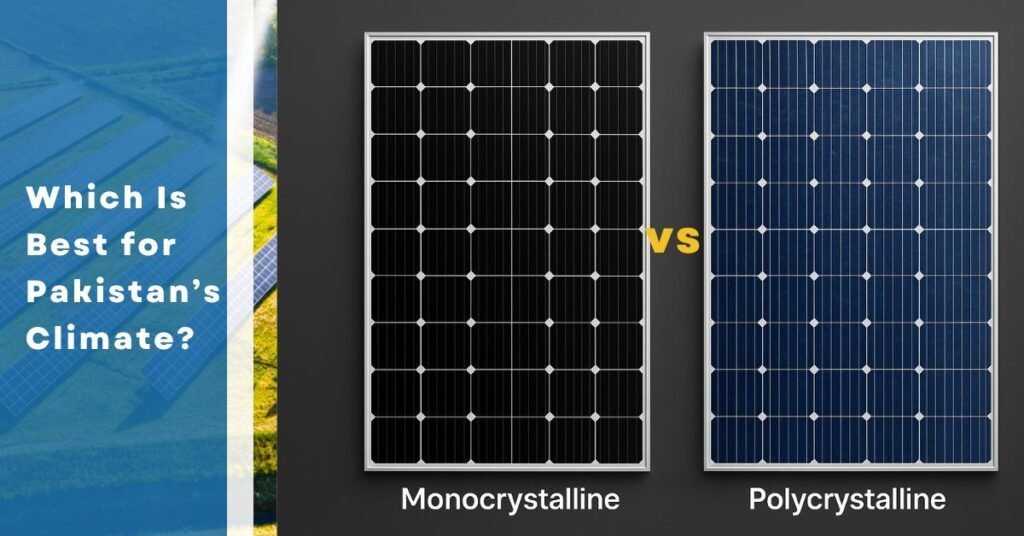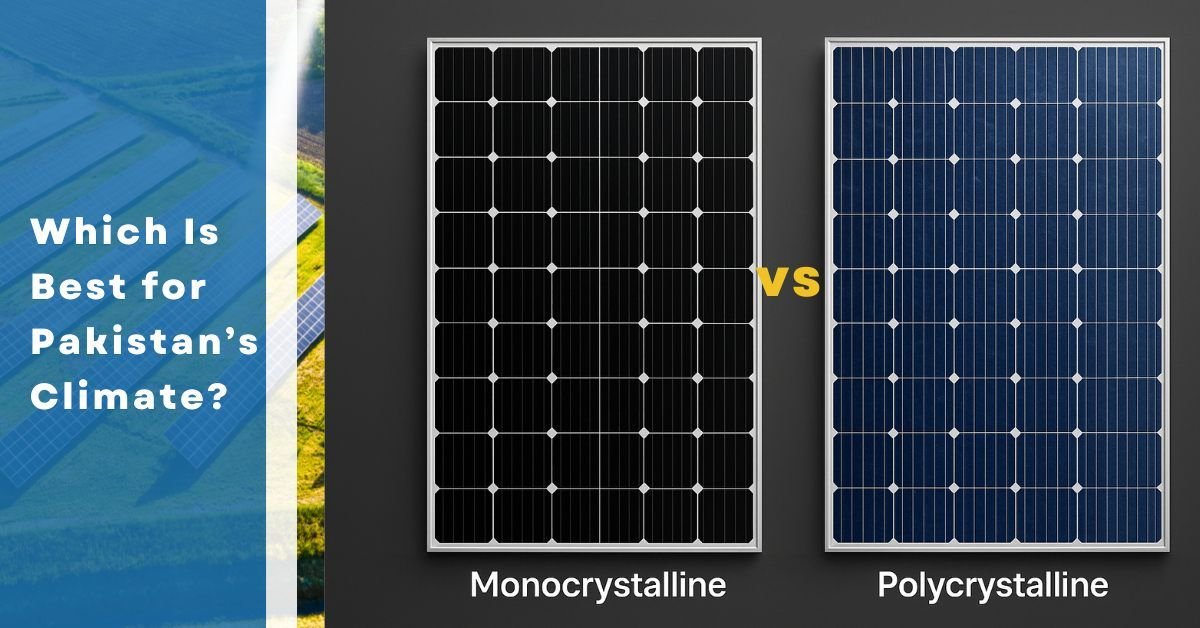Table of Contents
Standing on your rooftop in Karachi under the scorching 45°C sun, with sweat dripping down your forehead and another sky-high electricity bill in your hand — it’s a scene many Pakistanis know all too well. As power outages and rising utility costs become a daily struggle, more than 40% of households in Pakistan have turned to solar energy. It’s no longer a luxury — it’s a survival strategy. But even as solar panels grow in popularity, one critical question still puzzles many homeowners: Should you go for monocrystalline or polycrystalline panels?
This choice matters. It affects not only your upfront investment but also the efficiency of your system in Pakistan’s extreme climate. With high heat, dust storms, humidity, and unreliable grid electricity, selecting the right type of solar panel is not just a technical decision — it’s a practical one that directly impacts your savings and energy independence.
The goal is clear: get maximum output, spend less over time, and future-proof your home against rising power costs. But which panel type actually delivers on that promise in Pakistan?
Monocrystalline vs polycrystalline panels: which is best for pakistan’s climate?
Choosing between monocrystalline and polycrystalline solar panels isn’t just about price—it’s about performance, durability, and long-term value under Pakistan’s extreme weather conditions. In this guide, we’ll break down how each panel type performs in high heat, humidity, dust, and load shedding scenarios—so you can make a confident, cost-effective decision for your home or business.
What Are These Panel Types Anyway?
Think of solar panels like different types of rice. You have basmati (premium) and regular rice (standard). Both fill your stomach, but one costs more and has better quality.
Monocrystalline panels are like basmati rice – premium quality. They’re made from single silicon crystals, which makes them pure and efficient. These panels typically offer efficiency rates exceeding 20%, meaning they convert more sunlight into electricity.
Polycrystalline panels are like regular rice – good quality but less refined. They’re made from multiple silicon crystals melted together. These panels have around 15% efficiency, which is still pretty good for most homes.
The Pakistan Climate Challenge
Pakistan’s weather is tough on everything, including solar panels. We have:
- Scorching summers with temperatures hitting 50°C
- Dusty winds that cover everything in sight
- Monsoon humidity that makes you feel like you’re swimming through air
- Intense sunlight that could cook an egg on the pavement
Solar cell performance decreases with increasing temperature, fundamentally owing to increased internal carrier recombination rates. This means when it gets really hot, your panels work less efficiently. It’s like trying to run a marathon in summer – you just can’t perform at your best.
Real-World Performance: The Taxila Study
Here’s where things get interesting. Researchers in Taxila, Pakistan, did a real-world test comparing both panel types in actual Pakistani conditions. The study examined monocrystalline and polycrystalline modules under outdoor conditions, calculating power output, module efficiency, and performance ratios while investigating the effects of module temperature and solar irradiance.
The results? Both panel types showed strong dependence on temperature and sunlight intensity. But here’s the kicker – the performance gap between them wasn’t as big as the price difference suggests.
Heat Performance: The Make-or-Break Factor
In Pakistan’s climate, heat performance is everything. When temperatures soar above 40°C (which happens frequently), solar panels start losing efficiency. Studies show that increasing air gaps from 2 cm to 20 cm can reduce panel temperature by up to 10°C.
Monocrystalline panels handle heat slightly better due to their pure silicon structure. They maintain more consistent performance even when your roof feels like a frying pan.
Polycrystalline panels lose a bit more efficiency in extreme heat, but the difference might not be as dramatic as you think – especially considering the price gap.
The Dust Factor Nobody Talks About
Living in Pakistan means dealing with dust. Lots of it. Whether you’re in Lahore’s smog or Quetta’s desert winds, dust settles on everything. Solar panels perform well in low light conditions and are suitable for Pakistan’s climate with cloudy days.
Both panel types get equally dirty, but here’s what matters: cleaning frequency and efficiency loss. Monocrystalline panels tend to bounce back to full efficiency faster after cleaning, while polycrystalline panels might need more frequent maintenance.
Durability in Pakistani Weather
Research shows that monocrystalline panels lose less efficiency than their polycrystalline counterparts when faced with harsh weather conditions like hail storms – which are becoming more common in northern Pakistan.
Monocrystalline advantages:
- Better resistance to temperature fluctuations
- Longer lifespan (25+ years vs 20-25 years)
- More stable performance over time
Polycrystalline advantages:
- Lower upfront cost
- Good enough performance for most homes
- Easier to replace if damaged
The Money Question: Cost vs Value
Let’s talk rupees. Monocrystalline panels are more expensive than polycrystalline panels due to their higher efficiency. But is the extra cost worth it?
Here’s a simple calculation:
- A 10kW monocrystalline system might cost Rs. 200,000 more than polycrystalline
- But it produces 15-20% more electricity over its lifetime
- In Pakistan’s expensive electricity market, this extra production pays for itself in 8-10 years
- After that, it’s pure savings for the next 15+ years
Space Considerations for Pakistani Homes
Most Pakistani homes don’t have unlimited roof space. Whether you live in a Karachi apartment building or a Lahore house, every square foot counts.
Monocrystalline panels require less space compared to other types to produce the same amount of energy. If your roof space is limited, monocrystalline panels let you generate more power from the same area.
For example:
- To generate 5kW, you need about 20 polycrystalline panels
- The same 5kW needs only 16-17 monocrystalline panels
- That’s 3-4 panels less, saving valuable roof space
Installation Reality Check
Here’s what solar installers in Pakistan won’t always tell you upfront:
Installation challenges with both types:
- Pakistani roofs aren’t always perfectly angled for solar
- Structural integrity varies widely
- Local electrical systems need careful integration
- Maintenance access can be tricky
The good news: Both panel types install the same way. Your choice won’t complicate the installation process.
Regional Performance Differences
Pakistan is a big country with different climates:
Northern regions (Islamabad, Peshawar):
- Cooler temperatures favor both types equally
- More cloud cover requires efficient panels
- Monocrystalline slight edge
Central regions (Lahore, Faisalabad):
- Extreme heat and dust
- Both types perform adequately
- Cost becomes bigger factor
Southern regions (Karachi, Hyderabad):
- High humidity and heat
- Coastal salt air affects all panels
- Durability matters more than peak efficiency
Western regions (Quetta, Multan):
- Desert conditions with temperature extremes
- Dust storms are frequent
- Robust build quality essential
Maintenance Reality in Pakistan
Let’s be honest about maintenance. In Pakistan, “set it and forget it” rarely works for anything. Solar panels need regular cleaning, especially during dust season.
Cleaning frequency needed:
- Summer months: Every 2-3 weeks
- Winter months: Every 4-6 weeks
- Post-dust storm: Immediately
Both panel types need the same maintenance schedule, but monocrystalline panels bounce back to full efficiency faster after cleaning.
The Warranty Game
Quality panels come with long lifespans, often with substantial warranties. In Pakistan’s market:
Monocrystalline warranties:
- 25-year performance warranty
- 10-15 year product warranty
- Better track record of companies honoring warranties
Polycrystalline warranties:
- 20-25 year performance warranty
- 10-12 year product warranty
- More variability in warranty service
Future-Proofing Your Investment
Think about where Pakistan’s energy sector is heading:
- Net metering policies are evolving
- Electricity prices keep rising
- Energy storage (batteries) is becoming more affordable
- Smart grid integration is coming
Monocrystalline panels integrate better with future technologies like battery storage and smart energy management systems. They’re also more likely to maintain their value if you ever sell your home.
The Environmental Angle
Both panel types are environmentally friendly, but there are differences:
Manufacturing impact:
- Monocrystalline: Higher energy input during manufacturing
- Polycrystalline: Lower manufacturing energy requirements
Lifecycle impact:
- Monocrystalline: Higher efficiency means fewer panels needed
- Polycrystalline: More panels required for same output
In Pakistan’s context, where reducing carbon footprint matters for future generations, the higher efficiency of monocrystalline panels often outweighs their manufacturing impact.

Making the Right Choice for You
Here’s the bottom line: Your choice depends on your specific situation.
Choose monocrystalline if:
- You have limited roof space
- You plan to stay in your home for 15+ years
- You want maximum long-term savings
- You live in an area with extreme temperatures
- You can afford the higher upfront cost
Choose polycrystalline if:
- You have plenty of roof space
- You’re on a tight budget
- You’re not sure about long-term plans
- You want good performance without premium cost
- You’re installing a large system where cost per watt matters most
The Pakistan Solar Success Story
More than 40% of homes have solar panels on their rooftops in Pakistan as of 2024. This isn’t just a trend – it’s a necessity. With electricity costs rising and power outages still common, solar power isn’t luxury anymore; it’s smart planning.
Whether you choose monocrystalline or polycrystalline, you’re making a decision that will:
- Cut your electricity bills significantly
- Reduce your dependence on the grid
- Increase your property value
- Contribute to Pakistan’s energy independence
Final Recommendation
For most Pakistani homeowners, monocrystalline panels are worth the extra investment. The combination of higher efficiency, better heat tolerance, space savings, and longer lifespan makes them the smarter long-term choice.
However, if budget is your primary concern and you have adequate roof space, polycrystalline panels still offer good value and will serve you well for decades.
Remember: The best solar panel is the one you actually install. Don’t let perfect be the enemy of good. Both types will dramatically reduce your electricity bills and increase your energy independence.
The solar revolution in Pakistan is happening now. The question isn’t whether you should join it, but which panels will serve you best for the next 25 years. Choose wisely, install professionally, and enjoy the benefits of free electricity from the Pakistani sun.
Your future self – and your wallet – will thank you for making this decision today.
